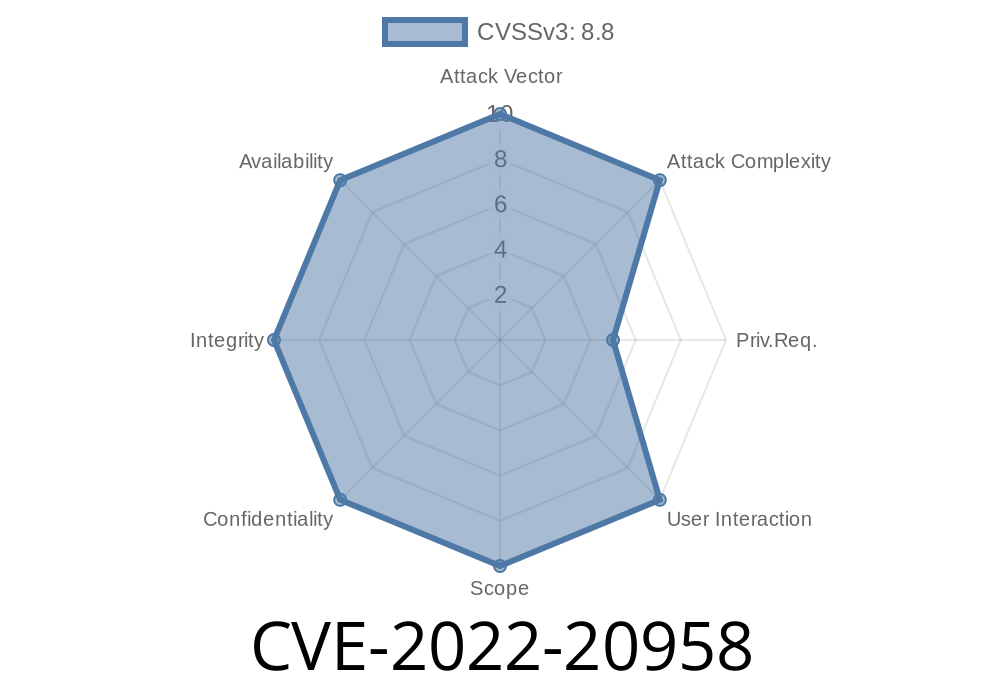A recently discovered server-side request forgery (SSRF) vulnerability in the web-based management interface of Cisco BroadWorks CommPilot application (CVE-2022-20958) poses a significant threat to affected devices, potentially allowing an attacker to obtain confidential information from the BroadWorks server and other devices on the network. This in-depth analysis will explore the vulnerability, its potential impact, and what you can do to protect your systems from this flaw.
Understanding CVE-2022-20958
The vulnerability, identified as CVE-2022-20958, stems from insufficient validation of user-supplied input within the CommPilot application's management interface. This lack of input validation enables an unauthenticated, remote attacker to perform an SSRF attack by sending a carefully crafted HTTP request to the web interface.
To exploit this vulnerability, the attacker simply needs to craft an HTTP request that targets an affected device. For instance, using the following example code snippet, an attacker can tamper with input values and bypass input validation:
POST /commPilotWeb/ HTTP/1.1
Host: vulnerable.server.com
Content-Type: application/x-www-form-urlencoded
Content-Length: {{value}}
vulnerableParam=%7b%7bvalue%7d%7d
The "%7b%7bvalue%7d%7d" part is where the attacker injects a malicious payload in its encoded form. If successful, the attacker can then obtain confidential information from the impacted BroadWorks server and other devices within the network.
For more information on this vulnerability and its impact, refer to the following resources
1. Cisco Security Advisory: https://tools.cisco.com/security/center/content/CiscoSecurityAdvisory/cisco-sa-broadworks-ssrf-CT4Ds7g9
2. CVE-2022-20958 Details: https://cve.mitre.org/cgi-bin/cvename.cgi?name=CVE-2022-20958
3. NIST Vulnerability DataBase: https://nvd.nist.gov/vuln/detail/CVE-2022-20958
Exploit Details
Exploiting this vulnerability allows an attacker to perform various malicious activities on the target network, including but not limited to:
Breaching other connected devices on the network
Given the nature of this SSRF vulnerability, it is crucial that organizations take swift action to mitigate potential damage.
To protect your systems from the CVE-2022-20958 vulnerability, you should
1. Apply patches: Cisco has released free software updates that address the vulnerability. Download and apply the appropriate patches according to your device and software version. Links to these can be found in the Cisco Security Advisory: https://tools.cisco.com/security/center/content/CiscoSecurityAdvisory/cisco-sa-broadworks-ssrf-CT4Ds7g9
2. Review and strengthen web input validation: Implement strong validation checks on all user-supplied inputs to prevent potential SSRF attacks.
3. Monitor network activity: Regularly monitor network traffic, log files, and device configurations for potential signs of malicious activity or unauthorized access.
4. Educate and train staff: Ensure all team members are aware of the risks associated with this vulnerability and the importance of timely patching and maintaining secure configurations.
Conclusion
The CVE-2022-20958 vulnerability highlights the importance of keeping security practices up-to-date and always being vigilant for potential threats in software applications. By understanding the vulnerability, taking advantage of the resources provided, and implementing the appropriate mitigation strategies, you can stay one step ahead of potential attackers and maintain a secure environment for your organization.
Timeline
Published on: 11/04/2022 18:15:00 UTC
Last modified on: 11/08/2022 15:52:00 UTC
